Why You Should Switch To Plastic-Free Microwave Food Covers

In today’s fast-paced world, microwaves have become an essential kitchen appliance, saving us time and effort when it comes to reheating food. However, convenience should not come at the expense of our health and the environment. We have written extensively about storing hot food in plastic containers and why we should avoid single-use plastic water bottles and even plastic baby bottles, because they all shed microplastics when exposed to high heat. Today we look at microwaving food with plastic covers and why this is not great for your health.
The Environmental Impact of Plastic Microwave Covers
Microwave food covers are usually made of cheap polypropylene (PP) plastic, so cheaply that they sell for only a couple of dollars in kitchen appliance stores. They are needed to cover your food and prevent spillage while you heat it with the microwave, saving you also hours of cleaning it afterwards. These ubiquitous plastic microwave covers, commonly used to prevent messy splatters and retain moisture during reheating, contribute to the mounting plastic pollution crisis, as they deteriorate over time, sometimes they even melt a bit, therefore they need to be replaced more often than glass for example.
Plastic pollution poses a significant threat to our oceans, wildlife, and overall ecosystem. As environmentally conscious consumers, it is crucial to explore sustainable alternatives to reduce our plastic footprint. In this blog article, we will dive into the world of plastic-free microwave covers and explore eco-friendly solutions for a greener, healthier kitchen.
Why Should You Cover Your Food in the Microwave?
Lightly covering your food while reheating it in the microwave keeps the steam close to your food ensuring that the dish reheats evenly, as it help retaining the moisture. So, it is better to reheat food covered as the food tastes better.
Are Plastic Microwave Plate Covers Safe?
According to recent studies, they are not. Even more worrying than the environmental impact of plastic microwaves is the health impact! When plastic is heated, it can release harmful chemicals into the air and food, posing potential health risks. Using plastic microwave covers may release microplastics and nanoplastic into your food as recently demonstrated by a study in the Journal of Environmental Science (1). This study investigated the release of microplastics and nanoplastics from polypropylene (PP) plastic containers and polyethylene-based (PE) reusable food pouches under different usage scenarios and came to the conclusion that some containers could release as many as 4.22 million microplastic and 2.11 billion nanoplastic particles from only one square centimeter of plastic area within 3 min of microwave heating. This is particularly concerning for heating baby food considering the size of babies and their development. The article mentioned here below provide further insights into this study and the use of plastic containers in contact with food.
Related: Is It Harmful to Store Food in Plastic Containers?
Alternatives to Plastic Microwave Splatter Covers
Fortunately, there is an array of eco-friendly alternatives to plastic microwave covers that can help us reduce our plastic waste footprint and protect our health. Let’s explore some of the healthiest microwave splatter covers that are plastic-free:
Ceramic Plates:
One of the safest things to cover food in a microwave is to simply utilize a ceramic plate or a soup plate on top of another ceramic flat plate. Or vice versa, use a flat plate as a cover if you’re using a ceramic soup plate or a bowl to reheat your meal. This is also the most budget method as everyone has soup plates already in their kitchen.
Glass Lids and Plates:
Using microwave-safe glass lids or plates can effectively cover food during reheating. Glass is a non-toxic and inert material that won’t leach harmful chemicals into your food, making it a safer option for your health. It’s usually available as borosilicate glass, which is more resistant to thermal shock than any other common glass, and usually as well less fragile and more durable.
Cotton Covers or Any Natural Fiber Cloths:
Organic cotton covers and cloths made with natural fibers like linen, or wool can be used as microwave oven food covers, provided they are made with 100% natural fabric that does not contain any synthetic material like polyester, rayon, or metallic threads, which can be flammable when heated in the microwave.
Silicone Microwave Covers:
Silicone microwave covers are flexible, easy to clean, and can be used repeatedly, making them a great alternative to disposable plastic covers. We’ve even seen collapsible silicone microwave covers online. Silicone is a durable, heat-resistant, and reusable material, however we do not recommend to use it in either the microwave, nor in the oven. A 2022 laboratory test (2) by the independent German organisation Oeko Test showed that in some cases chemicals from silicone baking forms migrated into food (the test is available only in German but you’re able to translate it via Google). They tested 20 baking forms for different manufacturers and found that seven silicone baking molds released more chemicals substances into food than the German Federal Institute for Risk Assessment recommends. A supplier had, therefore, to recall his product. Furthermore, they also found noticeable silicone components in the baked muffins themselves.
Reusable Silicone Food Storage Bags:
We’ve noticed reusable silicone food storage bags with a microwave-safe seal on the market as another claimed eco-friendly option. Some manufacturers claim that these bags can safely cover your food during reheating and are easy to clean and reuse. For the reasons mentioned above, we do not recommend using these products while cooking, baking or microwaving food.
Beeswax Wraps:
Beeswax wraps, made from organic cotton infused with beeswax and jojoba oil, can also be utilized to cover dishes in the microwave, but only in short burst of maximum up to 30 seconds and never exceeding 80 degrees C (176 degrees F), as otherwise they will melt and loose their form. These wraps are pliable, reusable, and can be washed with cool water and mild soap after each use.
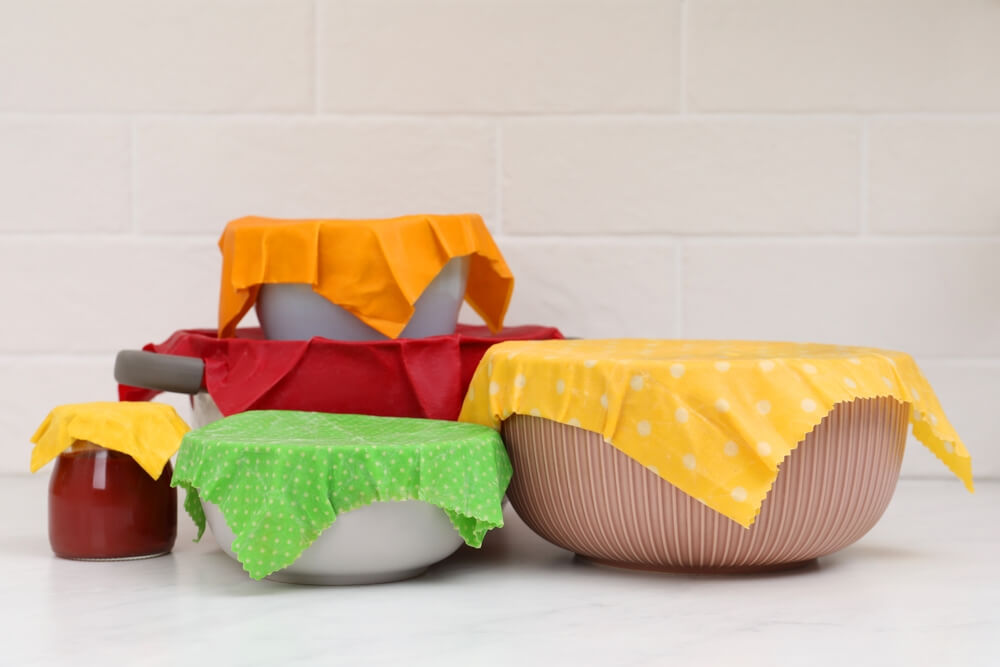
Image: Beeswax Wraps on Food Containers – unknown.
Related: Why You Should avoid Plastic Water Bottles?
4 Best Food Covers for Microwave Cooking with No Plastic
We have searched the web for the best and safest microwave covers with no plastic. Here below is our selection.
This post contains affiliate links, which means we may receive a small commission, at no cost to you, if you make a purchase through a link. This helps us continue the hard work we put into researching products and solutions to plastic/ microplastic pollution.
Important Disclaimer: While we make our best efforts to scout plastic-free products around the world, we are also aware that sometimes we do have to make some compromise, as long as still in line with our values. In this article, we are presenting the best versions of what is available on the market. Some of the covers have knob made of silicone a syntethic material, and we disclose it in the product description.
Please Note: Our health content is for informational purposes only and is not intended as professional medical advice. Consult a medical professional on questions about your health. Please read our disclaimer.
1. Tall Glass Microwave Splatter Cover for Food
This is a tall pure glass microwave splatter guard lid is made of borosilicate. The lid has a venting hole system that allows steam to escape in a safe manner, but also regulates the hot air to heat your food uniformly. The knob is made out of silicone and provides a safe grip, but it doesn’t touch the food from the inside of the lid. The design of this cover has been improved to include a ceramic screw, so no toxic chemicals can leach into the hot food.
Size: 11.75″L x 10″W, 3.2″H
Shop on Amazon USA – Canada – UK– Australia
Related: The Benefits of Switching to a Plastic Free Electric Kettle: 13 Non-Toxic Kettles To Consider
2. Tall Microwave Tempered Borosilicate Glass Plate Cover
This unbranded borosilicate glass plate cover is taller than the average microwave dish allowing you to heat up or cook meals of any size. This strong tempered borosilicate is sturdy, BPA-free, and Phthalate Free – meaning no plastics or chemicals will leak into your food. It has a silicone knob that provides a cool, firm grip for safe handling of the food cover.
Size: 10″ x 4″
Check the latest price on Amazon USA – Canada – Australia
Related: 11 Truly Non-Toxic Cookware Brands for a Healthy Kitchen, Tested & Reviewed
3. All Glass Microwave Cover – Non Toxic, Non Plastic Microwave Lid Guard
For those that don’t even want a silicone knob, we found this tall all glass splatter guard lid allows for a dirt and mess free experience while cooking or warming up food in the microwave. The lid features an oversized steam vent to keep food moist and prevent drying out. As even the lid is made of glass, this product comes with a bonus pair of heat-resistant gloves for safe handling. It is also dishwasher safe and refrigerator safe.
Size: 10″ x 5″ tall or 12″ x 5″ tall
Check the latest price on Amazon USA – Canada – Australia
Related: 17 Best Plastic Free Coffee Makers By Style For Delicious, Non-Toxic Coffee
4. Simax Casserole Borosilicate Glass Dish Set
Simac offers a plastic free casserole dish set consisting of three bowls & lids to cook your food in the oven or in the microwave without worrying about nasty chemicals leaching into your food. The products are made in Europe, in the Czech Republic, from shock resistant borosilicate glass that doesn’t not absorb odors or flavors. Their concept is a hassle free and worry-free “oven to table, to fridge, to microwave dish” using the same dish & cover to cook and store food everywhere in the kitchen saving you money in the long run. The casseroles can withstand temperatures between 572° and -40° Fahrenheit (300°/-40° Celsius).
Size: different combinations
Check the latest price on Amazon USA – Canada – UK – Australia
Related: Why a Plastic Free Blender is Better for Your Health
Conclusion: Switch to Non Toxic Microwave Cooking Covers!
As we strive to live more sustainably and healthy, it’s essential to make conscious choices in our daily routines, including in the kitchen. By ditching plastic utensils in the kitchen and adopting healthier alternatives like plastic free microwave food covers and casseroles, we can significantly reduce our plastic waste footprint, as products made of borosilicate glass are very durable and shock resistant, therefore they don’t break easily. Plus they are a very wise choice for our own health.
Remember, the little choices we make today can have a significant impact on our future health. So, let’s take a step towards a healthier kitchen and a cleaner world by embracing plastic-free microwave covers. Together, we can protect the environment and ourselves from nasty chemicals and leave a positive legacy for generations to come.
References and Scientific Literature Sources:
(1) https://pubs.acs.org/doi/full/10.1021/acs.est.3c01942
(2) https://www.oekotest.de/freizeit-technik/Muffinformen-aus-Silikon-Immer-wieder-landet-Plastik-im-Gebaeck_13329_1.html
Comments
Madison
June 12, 2024 at 11:22 pmWhat about the actual microwave? The interiors should be plastic free and made with non-toxic material? Mine is very old and so I would like to change it out. Do you have suggestions?
Doreen
June 20, 2024 at 6:35 pmGood article. I recently changed most of my dishes to Boroscilate glass for storing food. I do have hundreds of plastic containers to store cakes and biscuits in and wonder if this is safe for these items and cold food? It is startling to hear this news especially as I am a Queen of plasctic containers. I am now researching to buy non plastic non heavy microwave covers to heat food up in the microwave.
gerald underhill
September 26, 2024 at 10:16 pmyou might want to read the 1-3 reviews on amazon about the Cuchina product
Paweł
February 27, 2025 at 4:19 amWhy are you not recommending silicone microwave covers? What does the Oeko Test has to do with it? That research was about silicone baking forms, which is something completely different.
How can you compare a baking tray, which is in direct contact with food, in an oven, which usually has a much higher temperature and it’s turned on longer, to a microwave cover – which has no contact with food, and its heated faster in a lower temperature?
G.Lamby
March 22, 2025 at 8:12 amHow are you supposed to sterilize bottle nipples and bottles? (and please do not judge-breast feeding may not be an option)
Tracey
May 25, 2025 at 10:00 amI’m wondering about the safety of the silicon knobs on the glass food covers for the microwave please
Cathy
June 16, 2025 at 10:11 amAny products that aren’t only available at Amazon or Walmart?
Jeannie
July 10, 2025 at 8:45 amCan you please comment on Silicone covers that are BFA free? And can you comment on BFA free silicone in general for food storage. Thank you!
Dee
August 18, 2025 at 5:27 amHi
Thank you for such an informative article regarding plastic microwave covers. I have been using the same cover I purchased in 1987 !! It is not cracked nor chipped and I’ve always washed by hand. Because it’s 4 inches tall, it doesn’t touch the food however should toss this due to aging plastic?
Also, what do you recommend to use for sous vide cooking. I am using ZipLoc brand freezer bags. I have not used temperature greater than 165 Fahrenheit. Is this cooking method unsafe?
Lastly , regarding silicone bakeware — does that include silicone baking mats for cookies ?
Thanks so much!
Ainn
October 29, 2025 at 10:19 pmHi, thanks for a great informative article. My question is, is it safe to freeze uncooked meat , chicken or seafood in freezer safe plastic bags?
Thanks.
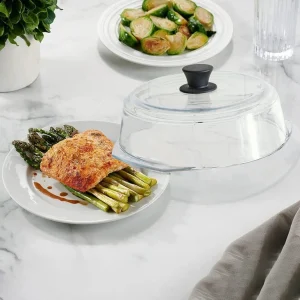

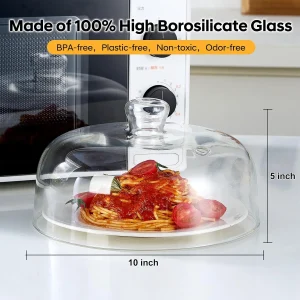
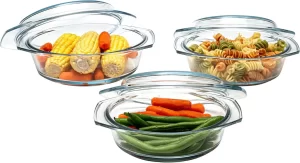
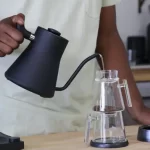




Andrew Donelson
February 11, 2024 at 11:56 amWhat about the plastic covers that cover the trays of foodwse buy im grocery stores intended for microwave.but thay you store such food boxes with thei intenal= plasticl covers over the trays insie your freezer until ready to be heated in microwave, You are told to either leave cover on or make holes in covering using microwave cooking.Are they safe? Do they contain PFAS or PFAS derived products? Thank you. A concerned consumer.My wife and infant son and I all got cancer ,both my (wife and sonwho as infant drank daily formula with Army water_ I got both kidney cancer and advanced prostate cancer while drinking the drinking water from the utilty connected tp our home water at 2 Army bases 1969 to 1971, Our highest ppt PFAS was 188,000. ppt in our water. We are trying to be caredul not to get our blood PFAS ppt of Forever Chemicals elevated even more.
I'm Plastic Free
February 11, 2024 at 3:15 pmHi Andrew,
Thank you for your comment and so sorry to hear that you and your family all have cancer. It’s tragic to see what happened with the use of PFAS and all other toxic chemicals around us… Please stay away from warming up any food or drink in plastic, particularly with cancer. If possible, transfer the food in a ceramic plate or bowl, then microwave it. My advice is to buy less processed food as possible as this has been found to contain microplastics too. Please read this article: https://oceanconservancy.org/news/its-not-just-seafood-new-study-finds-microplastics-in-nearly-90-of-proteins-sampled-including-plant-based-meat-alternatives/
PS: I’m not a medical expert, our disclaimers states this, however this what I would do.
Kind regards,
Simona